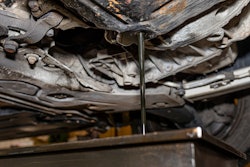
In 1917, when the federal excise tax (FET) was passed, there were under 400,000 trucks registered in the United States. Most of those concentrated on drayage and deliveries.
America had just entered World War I, with President Woodrow Wilson promising to organize and mobilize “all the material resources of the country to supply the materials of war and serve the incidental needs of the nation in the most abundant and yet the most economical and efficient way possible.”
That way was trucking. Railroads couldn’t handle the amount of freight, and trucking increased exponentially, adding another 200,000 trucks to the roads by the time peace was declared in 1918. The taxes paid on those trucks through the FET helped pay for the winning war effort.
The growth hasn’t stopped. Not only are there vastly more trucks on the road (close to 14 million, according to the American Trucking Associations), but they’re more complex than ever, with components and features never even dreamed of in 1917. The trucks running today’s highways are the lifeblood of the American economy. If you can touch it, no matter where you are, it probably spent some time on a truck.
Today’s excise tax isn’t paying for wars; that money (around $5 billion in 2023) goes into the federal Highway Trust Fund, which pays at least in part for most of the roads in the U.S. ($52 billion in 2022).
Here's the rub: America’s infrastructure is in bad shape. There’s little arguing that. The trust fund’s future isn’t looking very bright, either, with shortfalls projected starting in 2028 with all of the taxes feeding it remaining in place.
At the same time, trucking is facing increasing pressure to update its fleets and go green with alternative powertrains and lower emissions technology — with its notably higher price tags — being mandated by states and the federal government alike.
The FET adds another 12% to the cost of trucks new trucks. For a diesel truck with a price tag of around $180,000, that’s $21,600. For an alternative powertrain truck with a $400,000 price tag, that’s a whopping $48,000 added to the sale. Some battery-electric vehicles are exempt from the FET, and there are also incentives, grants, tax credits and other solutions in place to offset some of that cost.
[RELATED: Watch TPS' webinar on the federal excise tax]
The American Truck Dealers are absolutely correct in saying adding that much to the price tag — even with credits and such, which come with their own administrative costs — is a barrier to upgrading fleets to cleaner diesel and alternative-powered trucks, because someone has to pay and that someone is the future owner of the truck.
However, the FET is a valuable, though inconsistent, contributor to keeping America’s roads, highways and bridges in shape — a task not getting any cheaper and not an ideal situation for anyone even on the best of days. Repeated bills aiming to repeal the FET have failed, with the last set of bills in 2023 failing to make it out of committee.
Neither of the 2023 measures considered in the House and Senate proposed how the trust fund would replace what the FET put in the pot. Without a way to replace FET’s cash, especially as the fund faces looming shortfalls, a repeal bill isn’t likely to gain much traction.
The Congressional Budget Office (CBO) suggested increasing existing fuel taxes to cover the shortfall. Fuel taxes make up the lion’s share of the trust fund, and the FET’s $5 billion could be included in the increase. But that would make gasoline and diesel more costly, a drag on the economy that supports trucking in the first place. Plus, this wouldn’t include alternative powertrains running on fuels that don’t feed into the trust fund or are taxed minimally, if at all.
There’s also the option to institute new taxes or fees, including a tax on mileage traveled (VMT). As the CBO points out, though, such a tax would be more costly to administer and raises privacy concerns. A VMT could be limited to only commercial vehicles, but the set-up and administration costs remain higher than a fuel tax. A 2019 study updated to 2022 truck traffic shows a 5 cent-per-mile truck tax would generate between $5-15 billion, depending on the types of trucks and roads included in the tax.
The federal government could opt to keep bailing out the Highway Trust Fund from the general revenue fund, but then highways would have to compete with everyone else for its slice of the pie. Or it could incur more debt to keep the fund solvent and road spending on track, such as it is.
It is, like so much of commercial trucking, a more complex situation that meets the eye. And, like with many issues (I’m thinking of right to repair), it’s critically important the heavy-duty industry is in the driver’s seat, not only leading the charge to repeal the FET, but also how to replace it in the federal budget.









